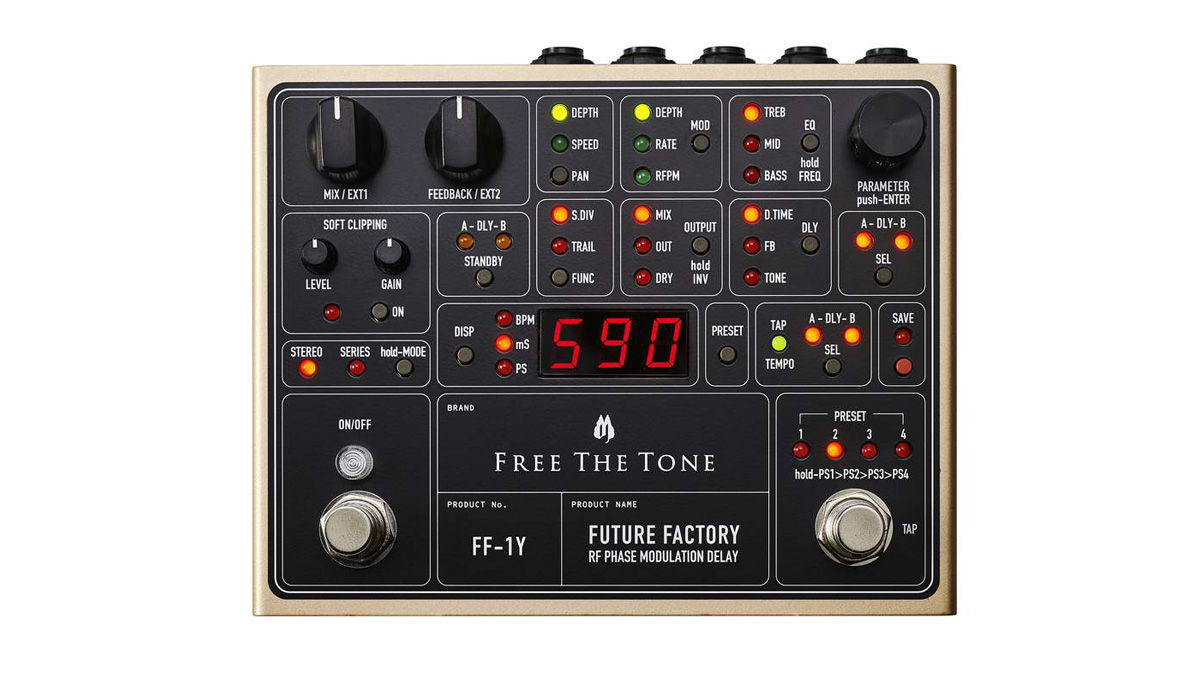MusicRadar Verdict
A very versatile pedal.
Pros
- +
Two delay lines in one box; huge range of delay times.
- +
Comprehensive set of parameter.
- +
Eeasily accessible presets.
- +
Soft clipping function.
Cons
- -
No separate MIDI in and out.
MusicRadar's got your back
Free The Tone’s Flight Time digital delay has had its fair share of admirers since its release, but its lack of stereo output will have deterred some potential users.
If that’s you, then you’ll no doubt be happy to know that the Flight Time has now been joined in the company’s roster by a new unit that this time offers stereo besides mono operation. Subtitled ‘RF Phase Modulation Delay’, the Future Factory claims to sport something unique in modulation, whereby instead of the LFO phase changing regularly at a preset cycle, it changes at random when the signal crosses a certain attenuation level, delivering more of a sense of the sound ‘floating in the air’.
Getting to the nuts and bolts of it, though, what we have here is a pedal that provides two independent digital delay lines (A and B) with various options to combine them - and both with optional modulation.A delay time range that runs from one millisecond lets you dial in everything from chorus, vibrato and flanging through all lengths of delay up to 10 seconds, so it’s possible to have composite effects such as chorus combined with a quarter-note delay, or a delay with two different delay times, for example. These can be set to run in series (A feeding B) or in parallel.
Sounds
There are a lot of parameters to set in this pedal, but not a lot of knobs. Mix and Feedback can be adjusted directly (and you can assign alternative functions to those two knobs if you wish), but most tweaks are selected by a series of small buttons and carried out by a turn-and-push parameter knob. This approach doesn’t really lend itself to quick ’n’ dirty onstage edits, although the display does always let you clearly see what’s going on.
Better, then, to rely on presets, of which the Future Factory stores 128, accessible via MIDI or the parameter knob, with four instantly available via pressing the Tap Tempo footswitch. In its nominal role, that footswitch gives you instant access to quick delay-time changes and is really practical - you can choose whether to apply it to delay A, B or both together, allowing you to, say, keep your chorus or short slapback in place while changing a preset’s longer delay time on the fly to match a drummer’s flights of fancy.
There’s plenty of opportunity for shaping the sound of your delay. To start with, the repeats have a Tone control that applies a low- or high-pass filter, and soft clipping can be applied for distortion. This way you can get away from the unit’s pleasantly pristine-sounding repeats and move towards the sounds of a vintage unit and beyond. However, each successive EQ’d and/or distorted repeat will still sound the same as its predecessor, so you can’t quite recreate the progressive degradation of a tape or BBD delay. Those parameters can be adjusted and stored for each preset, but on top of that there’s also three-band EQ, which can be globally applied to the delay.
Modulation can be applied using standard Depth and Rate parameters, but you also get to choose whether the RFPM (Random Fluctuating Phase Modulation) is on or off. While any extra dimensionality conferred by the RFPM is subtle, it’s good to have the extra option. Depth and Speed of panning when in stereo mode are adjustable, though in series mode these apply a cool tremolo to the delay signal; pure tremolo is possible if you set the minimum delay time and turn the dry sound off.
Want all the hottest music and gear news, reviews, deals, features and more, direct to your inbox? Sign up here.
You can choose to have simple single delays or a basic chorus, but it’s using those two delay lines together that makes the Future Factory a real tour de force. You have the ability to build up some brilliant-sounding complex modulated delays, and Free the Tone has programmed the first 100 preset slots with some very useful and inspirational variations. Whether you use it in a straight mono signal chain or in stereo, this pedal will deliver airy, spacious transformations of your guitar tone.
A very versatile pedal that will take care of all standard delay duties but specialises in composite sounds where modulation and delay combine to create unique ambiences. What’s more, four instant presets, tap tempo and expression pedal control of a chosen parameter make it a practical stage performer.
Trevor Curwen has played guitar for several decades – he's also mimed it on the UK's Top of the Pops. Much of his working life, though, has been spent behind the mixing desk, during which time he has built up a solid collection of the guitars, amps and pedals needed to cover just about any studio session. He writes pedal reviews for Guitarist and has contributed to Total Guitar, MusicRadar and Future Music among others.

